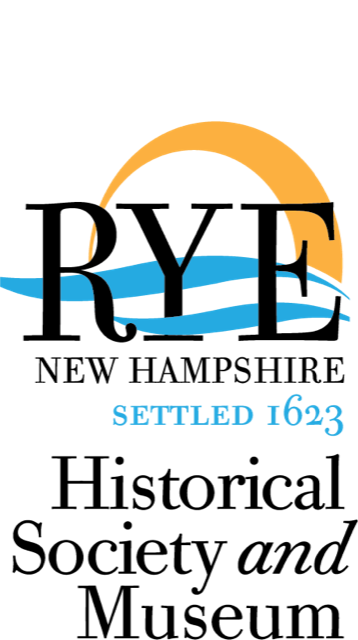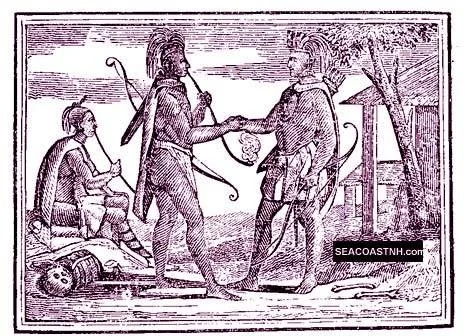History of Indigenous Peoples of the Seacoast
Hunter Stetz, Historian, Naturalist, Seacoast Science Center
Alex Herlihy, Rye Town Historian
The New Hampshire Seacoast has been home to ancestors of Algonquin-speaking peoples for at least 12,800 years. The coastline was then located where the Isles of Shoals are and the environment was tundra-like. The first native people were highly mobile hunter-gatherers who foraged plants and hunted mastodon, caribou, black bears, hares, beaver, and moose.
About 9,000 years ago, distinct cultures emerged and the warming climate grew the population. A wide variety of flora and fauna were hunted, foraged, and fished seasonally. Shell and fin fish were harvested by 7,500 years ago. Pottery developed about 3,000 years ago with more people settled in seasonal villages and with salt marshes providing more food. The Piscataqua River estuary also gave access to the interior and even more resources. 1,000 years ago, crops such as corn, beans, and squash (known as “the Three Sisters”) were cultivated. Inter-tribal trade networks spread extensively.
A rich mythology evolved through the oral tradition, recapturing past stories and passing them to younger generations. They provided not only a moral compass for how to live, but also provided practical educational information about how interact with Mother Earth (hunting, gathering, fishing, gardening, etc.) in a sustainable way. The stories reflected a closeness to the natural world where everything in nature had a spirit. Spiritual beliefs evolved around the Great Creator (“Kchi Niwaskw”) and their mythical helper, Gluscap. Gluscap was responsible for the abundance of nature which sustained the peoples (“Aln8bak”). Native women gained status in communities through their affinity for health and healing remedies. The seasonal way of life and shared workload did not require constant work. Village populations were always fluctuating throughout the year in accordance with available food and other resources. Indigenous groups in the Northeastern Woodlands lacked a rigid social hierarchy, instead putting emphasis on extended family relations. Because of New England’s notoriously acidic soil, stone tools are usually all that is left in the archaeological record. The Rye Town Museum has a small selection of these artifacts in its collection
Archaeology, written records and oral tradition indicates that the Piscataquak community of the Pennacook culture lived here prior to the arrival of Europeans. In 1608, Samuel de Champlain noted dwellings, extensive farming, and upwards of 200 people living around what today is Rye Harbor. Prior to the European settlement in 1623, native populations declined due to diseases from European explorers. Up to 90% of coastal Indigenous communities may have died over the course of these epidemics.
As the settler-colonist population grew in the 1600s, wars broke out with Indigenous peoples that brought their societies to near collapse, but survivors quickly regrouped inland and adapted to the changed times. At some point, the Pennacook and Abenaki cultures merged. The Mi’kmaq, Maliseet, Penobscot, Passamaquoddy, and Abenaki formed the Wabanaki (“People of the Dawnland”) Confederacy in the 1680s to retain their collective self-preservation. The local Abenaki-Pennacook population declined over time as a substantial amount migrated to what is now Québec, but some remained and integrated into American society, while still maintaining some cultural practices.
Well into the 20th century, Wabanaki from near and far sold woven baskets and other goods to locals and tourists in places like Rye. By the 21st century, changing attitudes toward native peoples empowered some to more publicly acknowledge their identity. Advocacy for Indigenous recognition has shown some improvement in relations between tribal groups and state governments, but challenges remain over land claims, repatriation of native artifacts, funerary issues, and who is the rightful authority to determination if one is Indigenous.
To understand this topic and all history fully, one has to take a nuanced view of our complex past and be open to facing and acknowledging all of it. For further information, search: Indigenous
New Hampshire Collaborative Collective (INHCC) https://indigenousnh.com/ and the Cowasuck Band of the Pennacook-Abenaki People https://www.cowasuck.org/.
The Role of Archaeology in Learning About the Seacoast
The roots of modern archaeology trace back to the incredible excavation of Pompeii in the 1700s and 1800s. Pompeii was a wealthy Roman city near Naples, Italy, which was covered with up to twenty feet of volcanic ash in 79 CE (Common Era). Another great excavation was done by Heinrich Schliemann at Troy on the west coast of Asia Minor (Turkey) in the 1800s. In the 1900s, one of the great finds was made by Howard Carter in the Egyptian Valley of the Kings where in 1922 he found the tomb of King Tutankhamun. Another highlight was the discovery of human remains in Tanzania by Louis & Mary Leakey, which pushed back the age of known human ancestors to nearly two million years ago.
Archaeology has had a profound influence on revisions to the historical record. Their dating of both urban empires and other areas all over the world and here in the US has drastically changed the view of the past and pushed that historical record much further back in time. In North America, two of the earliest archaeological discoveries that expanded the existing historical narrative were both in New Mexico. In 1908, George McJunkin, a formerly enslaved cowboy, identified the Folsom site, which contained projectile points dating from 13,000 to 12,000 years before the present. In 1929, Ridgely Whiteman discovered what are now known as Clovis points (named for the nearby town), which pushed human history even further to 13,400 years ago. Both of these tool styles have since been found in much of North America.
Two well- known sites in the American southwest where ruins have revealed highly developed habitation by indigenous peoples are found at the Anasazi (Ancient Ones or Ancestral Puebloans) ruins at Mesa Verde National Park in south west Colorado and the Chaco Canyon History Park in northwest New Mexico. In addition, significant archaeological work has been done with sites of the Aztecs in Mexico, the Mayans in Central America and the Incas in Peru. In all cases archaeologists in each of those regions have worked with international archaeologists to raise considerable awareness and enlightenment about the greatness of these Indian civilizations of the Western Hemisphere.
Wentworth Cheswill of nearby Newmarket is considered the godfather of New Hampshire archaeology and may be one of the first in the entire United States. In addition to his late 18th century digs, he is also the first known person of African descent to be elected to public office in the United States. Thomas Jefferson, the second president of the United States, excavated Indigenous burial mounds in Virginia around the same time.
One of the most significant digs that reveals the story of Native peoples was within the Seabrook-Hamptons Estuary in advance of the construction of the Seabrook Nuclear Power Plant. In 1973-1975, Charles Bolian of the University of New Hampshire led intensive excavations off of Rocks Road which revealed periodic occupation from the Late Archaic Period into the 1600s. This site revealed many shell-filled pits, human burials, metal items, and many different projectile points and pottery styles dating back 5,000 years. At a nearby intertidal site, another team, led by Brian Robinson of the University of Maine, worked during low tide, uncovering many stone and bone tools, seeds, and wooden posts. This area was occupied until rising sea levels submerged it around 3,400 years ago. Some of the identified animal bones belonged to the great auk (Pinguinus impennis), which went extinct in the mid-1800s.
In addition, the nearby Edgerly Farm and Hunt’s Island sites are of the same caliber of significance. Three of these sites had organic materials preserved by the salt marsh, which is rare in northern New England. For details on these and other sites in NH, see: The Archaeology of New Hampshire: Exploring 10,000 Years in the Granite State by David Starbuck (2006).
Another important archaeological discovery is that of African Americans buried in Portsmouth. In 2003, construction workers stumbled upon hexagonal coffins beneath Chesnut
Street. Documentary evidence, as well as cultural materials recovered and subsequent scientific analysis, indicated that this burial ground was for colonial-era African-Americans, both free and enslaved. In a special ceremony in May of 2015, all eight individuals that had been exhumed from the dig were reinterred on site which is now a memorial park. The African Burying Ground has enhanced our understanding of the hidden history of slavery and the struggles of African Americans in New Hampshire that had either been forgotten or oversimplified by the 21st century (See the documentary film: “Shadows Fall North” 2016).
The Seabrook-Hamptons estuary sites reveal what archaeology might well find if such digs were done in coastal areas of Rye. There is much about Native life yet to be uncovered in Rye and the Seacoast, but the archaeologists of today are limited to state- or federally-funded “ground-breaking” projects (such as highway construction or utility improvements), as well as privately-funded endeavors with the consent of the landowner. Parcels owned by the Town of Rye and the State of NH, as well as privately-owned property are all potential sites for archaeologists to work, but town government and land owners have to take the initiative to make that happen. In addition, historic institutions can sponsor archaeologists to educate the public about what is both known from past excavations and the possibility of future discoveries beneath our feet.



